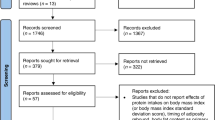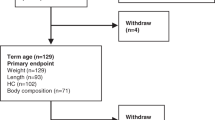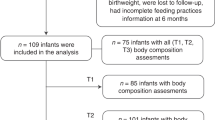Abstract
INTRODUCTION:
Higher protein intake during the first year of life is associated with increased weight gain velocity and body mass index (BMI). However, the relationship of protein intake and weight gain velocity with body composition is unclear.
OBJECTIVE:
To assess if the increases in weight gain velocity and BMI induced by protein intake early in life are related to an increase in fat or fat-free mass.
MATERIALS AND METHODS:
In all, 41 infants randomized at birth to a higher or lower protein content formula (HP=17 and LP=24, respectively) and 25 breastfed infants were included. Anthropometric measures were assessed at baseline, 6, 12 and 24 months, and fat-free mass (FFM) and fat mass (FM) were assessed by isotope dilution at 6 months.
RESULTS:
Weight gain velocity (g per month) during the first 6 months of life was significantly higher among HP infants (807.8 (±93.8) vs 724.2 (±110.0) (P=0.015)). Weight gain velocity strongly correlated with FM z-score (r=0.564, P<0.001) but showed no association with FFM z-scores. FFM showed no association with BMI. Nevertheless, FM strongly correlated with BMI at 6, 12 and 24 months (r=0.475, P<0.001; r=0.332, P=0.007 and r=0.247, P=0.051, respectively). FFM and FM z-scores did not differ significantly between HP and LP infants (0.32±1.75 vs −0.31±1.17 and 0.54±2.81 vs −0.02±1.65, respectively).
CONCLUSION:
Our findings support the hypothesis that higher protein intakes early in life are associated with faster weight gain and in turn to higher adiposity. This mechanism could be a determinant factor for later obesity risk.
This is a preview of subscription content, access via your institution
Access options
Subscribe to this journal
Receive 12 print issues and online access
$259.00 per year
only $21.58 per issue
Buy this article
- Purchase on Springer Link
- Instant access to full article PDF
Prices may be subject to local taxes which are calculated during checkout


Similar content being viewed by others
References
Koletzko B . Long-term consequences of early feeding on later obesity risk. Nestle Nutr Workshop Ser Pediatr Program 2006; 58: 1–18.
Ong KK, Loos RJF . Rapid infancy weight gain and subsequent obesity: systematic reviews and hopeful suggestions. Acta Paediatr 2006; 95: 904–908.
Stettler N, Zemel BS, Kumanyika S, Stallings VA . Infant weight gain and childhood overweight status in a multicenter, cohort study. Pediatrics 2002; 109: 194–199.
Ekelund U, Ong K, Linn Y, Neovius M, Brage S, Dunger DB et al. Upward weight percentile crossing in infancy and early childhood independently predicts fat mass in young adults: the Stockholm Weight Development Study (SWEDES). Am J Clin Nutr 2006; 83: 324–330.
Stettler N, Stallings VA, Troxel AB, Zhao J, Schinnar R, Nelson SE et al. Weight gain in the first week of life and overweight in adulthood: a cohort study of European American subjects fed infant formula. Circulation 2005; 111: 1897–1903.
Chomtho S, Wells JC, Williams JE, Davies PS, Lucas A, Fewtrell MS . Infant growth and later body composition: evidence from the 4-component model. Am J Clin Nutr 2008; 87: 1776–1784.
Arenz S, Ruckerl R, Koletzko B, von Kries R . Breast-feeding and childhood obesity -- a systematic review. Int J Obes Relat Metab Disord 2004; 28: 1247–1256.
Harder T, Bergmann R, Kallischnigg G, Plagemann A . Duration of breastfeeding and risk of overweight: a meta-analysis. Am J Epidemiol 2005; 162: 397–403.
Owen CG, Martin RM, Whincup PH, Smith GD, Cook DG . Effect of infant feeding on the risk of obesity across the life course: a quantitative review of published evidence. Pediatrics 2005; 115: 1367–1377.
Owen CG, Martin RM, Whincup PH, vey-Smith G, Gillman MW, Cook DG . The effect of breastfeeding on mean body mass index throughout life: a quantitative review of published and unpublished observational evidence. Am J Clin Nutr 2005; 82: 1298–1307.
Ziegler EE . Growth of breast-fed and formula-fed infants. Nestle Nutr Workshop Ser Pediatr Program 2006; 58: 51–63.
Heinig MJ, Nommsen LA, Peerson JM, Lonnerdal B, Dewey KG . Energy and protein intakes of breast-fed and formula-fed infants during the first year of life and their association with growth velocity: the DARLING Study. Am J Clin Nutr 1993; 58: 152–161.
Koletzko B, von Kries R, Closa R, Escribano J, Scaglioni S, Giovannini M et al. Lower protein in infant formula is associated with lower weight up to age 2 y: a randomized clinical trial. Am J Clin Nutr 2009; 89: 1–10.
Koletzko B, von Kries R, Closa R, Escribano J, Scaglioni S, Giovannini M et al. Can infant feeding choices modulate later obesity risk? Am J Clin Nutr 2009; 89: 1502S–1508S.
Wells JC, Fewtrell MS . Is body composition important for paediatricians? Arch Dis Child 2008; 93: 168–172.
Steinberger J, Moran A, Hong CP, Jacobs Jr DR, Sinaiko AR . Adiposity in childhood predicts obesity and insulin resistance in young adulthood. J Pediatr 2001; 138: 469–473.
Dunger DB, Salgin B, Ong K . Muscle mass and insulin sensitivity in children and adolescents. Horm Res 2006; 66 (Suppl 1): 79–84.
Dulloo AG, Jacquet J, Solinas G, Montani JP, Schutz Y . Body composition phenotypes in pathways to obesity and the metabolic syndrome. Int J Obes 2010; 34: S4–S17.
Dulloo AG, Jacquet J, Seydoux J, Montani JP . The thrifty /’catch-up fat/’ phenotype: its impact on insulin sensitivity during growth trajectories to obesity and metabolic syndrome. Int J Obes 2006; 30: S23–S35.
Wells JCK, Fewtrell MS . Measuring body composition. Arch Dis Child 2006; 91: 612–617.
International Atomic Energy Agency. Assessment of Body Composition and Total Energy Expenditure in Humans Using Stable Isotope Techniques. IAEA Human Health Series: Viena, Austria, 2009.
European Commission. Commission Directive 91/321/EEC of 14 May 1991 on infant and follow-on formulae. Official J Eur Comm 1991; 175: 35–49.
WHO Multicentre Growth Reference Study Group. WHO child growth standards: length/height-for-age, weight-for-age, weight-for-length, weight-for-height and body mass index-for-age: methods and development. WHO Press: Geneva, Switzerland, 2006.
Craig H . Isotopic standards for carbon and oxygen and correction factors for mass-spectrometric analysis of carbon dioxide. Geochim Cosmochim Acta 1957; 12: 133–149.
Cole TJ, Coward WA . Precision and accuracy of doubly labeled water energy expenditure by multipoint and two-point methods. Am J Physiol 1992; 263 (Part 1): E965–E973.
Racette SB, Schoeller DA, Luke AH, Shay K, Hnilicka J, Kushner RF . Relative dilution spaces of 2H-labeled and 18O-labeled water in humans. Am J Physiol Endocrinol Metab 1994; 267: E585–E590.
Fomon SJ, Haschke F, Ziegler EE, Nelson SE . Body composition of reference children from birth to age 10 years. Am J Clin Nutr 1982; 35: 1169–1175.
Butte NF, Hopkinson JM, Wong WW, Smith EO, Ellis KJ . Body composition during the first 2 years of life: an updated reference. Pediatr Res 2000; 47: 578–585.
UIS. International Standard Classification of Education: ISCED 1997. UIS/TD/06-01, 1–48. UNESCO Library: Montreal Canada, 2006.
Ay L, Van Houten VAA, Steegers EAP, Hofman A, Witteman JCM, Jaddoe VWV et al. Fetal and postnatal growth and body composition at 6 months of age. J Clin Endocrinol Metab 2009; 94: 2023–2030.
Wells JC . The programming effects of early growth. Early Hum Dev 2007; 83: 743–748.
Peneau S, Rouchaud A, Rolland-Cachera MF, Arnault N, Hercberg S, Castetbon K . Body size and growth from birth to 2 years and risk of overweight at 7-9 years. Int J Pediatr Obes 2011; 6: e162–e169.
Ong KK . Early determinants of obesity. Endocr Dev 2010; 19: 53–61.
Rolland-Cachera MF, Deheeger M, Akrout M, Bellisle F . Influence of macronutrients on adiposity development: a follow up study of nutrition and growth from 10 months to 8 years of age. Int J Obes Relat Metab Disord 1995; 19: 573–578.
Gunther AL, Buyken AE, Kroke A . Protein intake during the period of complementary feeding and early childhood and the association with body mass index and percentage body fat at 7 y of age. Am J Clin Nutr 2007; 85: 1626–1633.
Wells JC, Chomtho S, Fewtrell MS . Programming of body composition by early growth and nutrition. Proc Nutr Soc 2007; 66: 423–434.
Arenz S, Kries R . Protective effect of breast-feeding against obesity in childhood: can a meta-analysis of published observational studies help to validate the hypothesis? In: Goldberg G, Prentice A, Prentice A, Filteau S, Simondon K (eds). Breast-Feeding: Early Influences on Later Health. Springer: The Netherlands, 2009, pp 145–152.
Dewey KG . Is breastfeeding protective against child obesity? J Hum Lact 2003; 19: 9–18.
Clifford TJ . Breast feeding and obesity. BMJ 2003; 327: 879–880.
Cope MB, Allison DB . Critical review of the World Health Organization's (WHO) 2007 report on ‘evidence of the long-term effects of breastfeeding: systematic reviews and meta-analysis’ with respect to obesity. Obes Rev 2008; 9: 594–605.
Wells JC, Coward WA, Cole TJ, Davies PS . The contribution of fat and fat-free tissue to body mass index in contemporary children and the reference child. Int J Obes Relat Metab Disord 2002; 26: 1323–1328.
Wells JC . A critique of the expression of paediatric body composition data. Arch Dis Child 2001; 85: 67–72.
Wells JC . A Hattori chart analysis of body mass index in infants and children. Int J Obes Relat Metab Disord 2000; 24: 325–329.
Butte NF, Wong WW, Fiorotto M, Smith EO, Garza C . Influence of early feeding mode on body composition of infants. Biol Neonate 1995; 67: 414–424.
Butte NF, Wong WW, Hopkinson JM, Smith EO, Ellis KJ . Infant feeding mode affects early growth and body composition. Pediatrics 2000; 106: 1355–1366.
Shepherd RW, Oxborough DB, Holt TL, Thomas BJ, Thong YH . Longitudinal study of the body composition of weight gain in exclusively breast-fed and intake-measured whey-based formula-fed infants to age 3 months. J Pediatr Gastroenterol Nutr 1988; 7: 732–739.
Acknowledgements
We gratefully acknowledge Judith Marine and Silvia Olive for their valuable contributions to perform the field work and to Pilar Hernandez from IISPV for her advices on statistics. We are very grateful to the study participants for their commitment with the project and the study team.
DISCLAIMER
This manuscript does not necessarily reflect the views of the Commission and in no way anticipates the future policy in this area. Berthold Koletzko is the recipient of a Freedom to Discover Award of the Bristol Myers Squibb Foundation, New York, NY, USA.
Author information
Authors and Affiliations
Consortia
Corresponding author
Ethics declarations
Competing interests
The studies reported herein have been carried out with partial financial support from the Commission of the European Communities, specific RTD Programme ‘Quality of Life and Management of Living Resources’, within the 5th Framework Programme, research Grants no. QLRT-2001-00389 and QLK1-CT-2002-30582, and the 6th Framework Programme, contract no. 007036.
Appendix
Appendix
European Childhood Obesity Trial Study Group:
Beyer J, Fritsch M, Haile G, Handel U, Hannibal I, Kreichauf S, Pawellek I, Schiess S, Verwied-Jorky S, von Kries R, Weber M (Children's University Hospital, University of Munich Medical Centre, Munich, Germany), Zaragoza-Jordana M (Pediatrics Unit, Universitat Rovira i Virgili, Reus, Spain), Gruszfeld D, Socha P, Dobrzańska A, Janas R, Kowalik A, Pietraszek E, Stolarczyk A, Socha J (Children's Memorial Health Institute, Warsaw, Poland), Carlier C, Dain E, Van Hees JN, Goyens P, Hoyos J, Langhendries J-P, Martin F, Poncelet P, Xhonneux A, Poncelet P (ULB Bruxelles and CHC St Vincent Liege), Perrin, E (Danone Research Centre for Specialized Nutrition, Schiphol, The Netherlands), Agostoni C, Giovannini M, Re Dionigi A, Riva E, Scaglioni S, Vecchi F, Verducci E (University of Milan).
Rights and permissions
About this article
Cite this article
Escribano, J., Luque, V., Ferre, N. et al. Effect of protein intake and weight gain velocity on body fat mass at 6 months of age: The EU Childhood Obesity Programme. Int J Obes 36, 548–553 (2012). https://doi.org/10.1038/ijo.2011.276
Received:
Revised:
Accepted:
Published:
Issue Date:
DOI: https://doi.org/10.1038/ijo.2011.276
Keywords
This article is cited by
-
Protein and growth during the first year of life: a systematic review and meta-analysis
Pediatric Research (2023)
-
Feeding patterns and BMI trajectories during infancy: a multi-ethnic, prospective birth cohort
BMC Pediatrics (2021)
-
Breastfeeding Practices and Overweight/Obesity Among Children Under 5 Years of Age: A Multistage Random Sampling Survey in Central and Western China
Maternal and Child Health Journal (2020)
-
Food, water, energy, and macronutrient intake of non-breastfed infants and young children (0–3 years)
European Journal of Nutrition (2020)
-
Clinical evaluation of two different protein content formulas fed to full-term healthy infants: a randomized controlled trial
BMC Pediatrics (2018)



